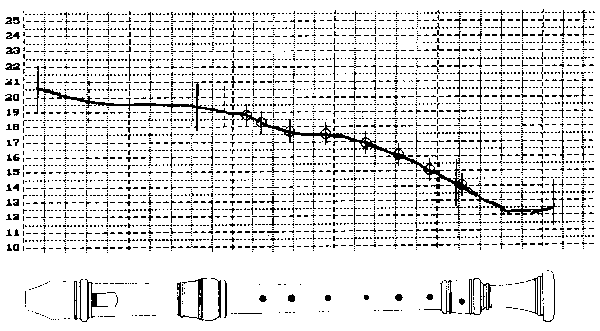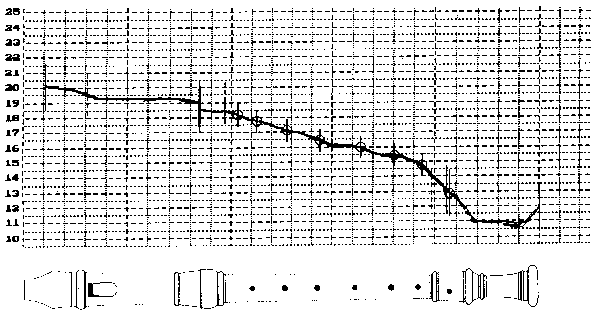4 The Late baroque recorder
The instrument experienced a clear change towards the end of the 17th century. The development probably had its roots in France and then by was “exported” by instrument makers to all of Europe.
Thus for instance P. Bressan brought this redeveloped type of high-baroque recorder to England, while Johann Christoph Denner domesticated the new recorder in Nuremberg following his studies in France.
4.1 Goals of the development
A notable characteristic of the new developments was the transformation of the recorder from a mere musical tool to the status of a work of art, already outwardly visible through the often complex adornment of the sections, where often rare and noble materials such as ivory came increasingly into use.
Likewise, the sound concept changed similarly More elegance increasingly demanded what was to be called: reedier tone with expressed soloistic development and above all, playing security in the high registers.
4.2 Structural Differences to the early Baroque Recorder
This may be noted in a number of constructional changes. The tapering of the bore towards the lower end is clearly steeper and begins further up than with the early baroque instruments. With it also the finger holes move closer together and are smaller. The windway becomes increasingly thinner and in the process flatter.
4,3 Tonal consequences of the development
These changes lead to strong changes in the tone quality of the instruments, which is ever more strongly covered and richer in overtones, according to the ideal of the time. Strongly soloistic, it is also less suitable for mixed playing – the baroque recorder is avowedly “soloistic”. It is not surprising that the tendency moved again towards somewhat quieter, more intimate sounds.
4.4 Different “schools”:
Now different national and regional architectural styles can clearly be discerned. Particularly interesting for instance is the comparison between the instruments of the London and the Nürnberg schools, represented by the names Bressan and Denner.
The typical English recorder was developed in London particularly by P. Bressan, who introduced the instrument of France, and the makers from the Stanesby family.
The dominant characteristic is above all the bore diameter, which is relatively wide within the lower range, and which narrows itself towards the foot joint only gradually, so that also the foot bore is still relatively wide. The wind-way and cut-up are often kept relatively narrow, with very clearly perceptible blowing resistance.

Bore profile – alto recorder of P. Bressan
The tone quality is typified by “depth” in the basic tone which is very colorful and shapeable. One automatically thinks of the influence of French music, which shines through clearly here.
The high register of these instruments, is however often not the “strongest” register, particularly regarding purity of intonation. This is not surprising, if one considers English music of this time, e.g. recorder sonatas of Händel, in which the high notes of the third register are actually required very rarely. But the music is laid out for its tonal brilliance and is conceived exactly appropriately for an original recorder from Bressan’s workshop.
A further development overtook the building of recorders in Nuremberg, at that time the most important German center of building of woodwind instruments. Doubtless due to intensive trading contacts to the South, a clear Italian influence was discernible in the making of wind instruments. Thus a southern German recorder style was developed there, which was strongly influenced by the Italian taste.
Compared particularly with the English instruments of the time, they clearly exhibit a narrower bore particularly towards the lower end; the upper half of the bore shows comparatively small differences, which were primarily intonation-driven. However, starting from the finger hole 6 the bore narrows very strongly in these instruments, so that the foot joint bore is very narrow. At their narrowest points they can be narrower by up to 1.5 mm than, for instance, with Bressan’s instruments.

Bore profile of an alto recorder after J. Denner
However the wind-way is usually somewhat wider than with the English instruments. Whilst differences of 0.5 mm may not appear too serious, here they have very clear effects tonally. Also, the wind-ways are not usually kept as fine.
The tonal results are then also completely different from Bressan. Denner instruments characterised above all out by fast and direct speech everywhere, but above all however in the high register. The sound is usually slim but sonorous in the low register, the flexibility is clearly narrower than with English recorders.
The musical significance of this recorder type becomes clear immediately, if one considers the recorder works of Telemann. In all probability this composer possessed instruments from Jacob Denner’s workshop. His music requires instruments which have to be playable virtuosically in all registers, with no “weak” registers. The instruments had to be above all agile and fast-speaking.
Words are inadequate to provide a player’s comparison between the two instrument types. One should compare appropriate copies from a good workshop.
Here it is however important to compare instruments of the same pitch since pitch affects the character of an instrument beyond its building method profoundly. Original English instruments normally had deeper pitch (A = 405 - 408 Hz) than the Nürnberg instruments (A = 410 - 415 Hz)
